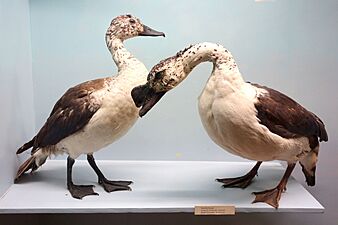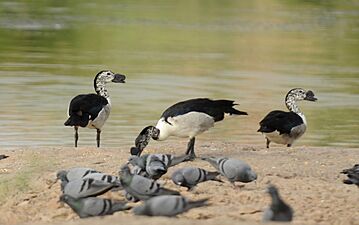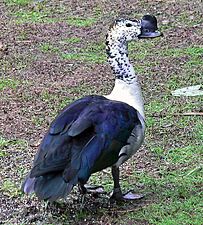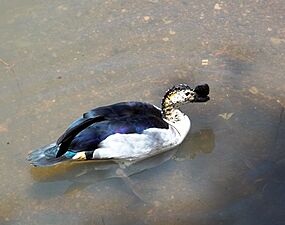Knob-billed duck facts for kids
Quick facts for kids Knob-billed duck |
|
|---|---|
 |
|
| Male, Lake Ziway, Ethiopia | |
 |
|
| Female, India | |
| Conservation status | |
| Scientific classification | |
| Genus: |
Sarkidiornis
|
| Species: |
melanotos
|
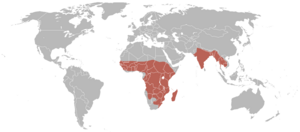 |
|
| Global range | |
| Synonyms | |
|
Anser melanotos Pennant, 1769 |
|
The knob-billed duck (Sarkidiornis melanotos), also called the African comb duck, is a large type of duck. You can find it in warm, wet areas like wetlands and rivers. These ducks live in Sub-Saharan Africa, the island of Madagascar, and parts of South Asia and Indochina.
Scientists used to think the knob-billed duck and the comb duck were the same. Now, most experts classify them as different species. There was even a mix-up with an extinct Mauritian comb duck, which turned out to be a different bird entirely!
Contents
About the Knob-billed Duck
The knob-billed duck is easy to spot because of its unique look. It is one of the biggest duck species around.
What Does It Look Like?
These ducks can be from 56 to 76 centimeters (about 22 to 30 inches) long. Their wings can spread out from 116 to 145 centimeters (about 45 to 57 inches) wide. They usually weigh between 1 and 2.9 kilograms (about 2.3 to 6.4 pounds).
Adult knob-billed ducks have a white head with dark spots. Their neck and belly are pure white. Their upper body is a shiny blue-black. You might see hints of blue and green, especially on their lower wing feathers. This shiny effect is called iridescence, like a rainbow shimmer.
The male duck is much bigger than the female. He also has a large, black knob on his bill, which is how the duck gets its name! Young ducks are duller in color, with a light brown belly, face, and neck. Their upper parts are dull brown.
Knob-billed ducks are generally larger than comb ducks. Their sides are usually lighter, often light gray, and sometimes whitish in females. If you see a young knob-billed duck, it might look a bit like a large, grayish female cotton pygmy goose. However, young knob-billed ducks are usually seen with adults, making them easier to identify.
These ducks are mostly quiet. They only make a low croaking sound if they are startled and fly away.
Where Do They Live?
Knob-billed ducks make their homes in calm, freshwater swamps and lakes in tropical areas. They usually stay in one place, but they might move around a bit during the wet season.
What Do They Eat?
These ducks mostly eat plants. They graze on grass or dabble in the water to find food. They also eat small fish, tiny water creatures called invertebrates, and seeds. Sometimes, they can become a problem for farmers who grow rice.
Knob-billed ducks often like to perch in trees. You usually see them in groups. During the wet season, the groups are small. In the dry season, they can gather in flocks of up to 100 birds! Sometimes, males and females might even form separate groups.
Are They Endangered?
Even though their numbers are going down in some local areas, the knob-billed duck is not considered globally threatened. This is because they live in such a wide range of places. The IUCN (International Union for Conservation of Nature) lists them as a species of "Least Concern." They are also protected by an agreement called the Agreement on the Conservation of African-Eurasian Migratory Waterbirds.
Reproduction and Life Cycle
Knob-billed ducks in Africa usually breed during and after the rainy season. If there isn't enough rain, they might not breed that year.
Nesting and Eggs
These ducks mostly build their nests in holes in trees. They can also nest in tall grass.
Male knob-billed ducks can have two mates at the same time. They might even have up to five different mates one after another. The males protect the females and their young, but they don't defend the actual nest sites.
Female ducks lay between 7 and 15 eggs. The eggs are usually yellowish-white.
Gallery
-
Flying knob-billed duck / comb duck at Chilika Lake, Odisha, India
-
Knob-billed Duck (Sarkidiornis melanotos) alongside Eurasian Coot ((Fulica atra) in Keoladeo National Park, Rajasthan, India



